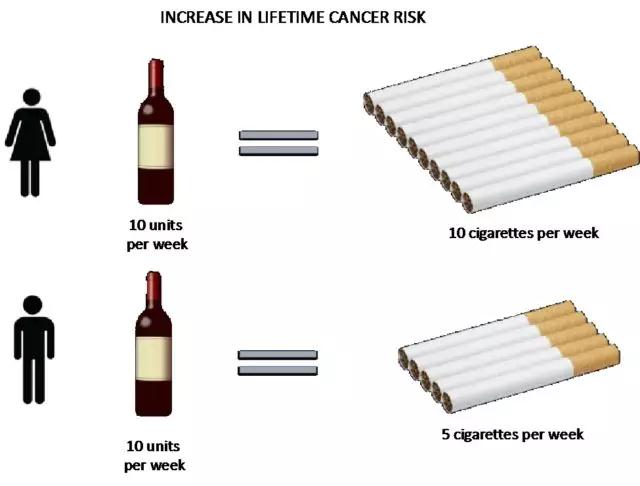|
|
| 喝一瓶酒等于抽多少支烟?巧妙换算助力风险科普 | BMC Public Health |
|
论文标题:A comparison of gender-linked population cancer risks between alcohol and tobacco: how many cigarettes are there in a bottle of wine?
期刊:BMC Public Health
作者:Theresa J. Hydes, Robyn Burton, Hazel Inskip, Mark A. Bellis and Nick Sheron
发表时间:2019/03/28
数字识别码:10.1186/s12889-019-6576-9
原文链接:https://bmcpublichealth.biomedcentral.com/articles/10.1186/s12889-019-6576-9?utm_source=other&utm_
medium=other&utm_content=null&utm_campaign=BSCN_2_WX_BMCPublicHealth_Arti_Scinet
微信链接:https://mp.weixin.qq.com/s/lgeKzw6lObIcvlXn7pFVcA
最近发表在开放获取期刊BMC Public Health上的一项研究显示,癌症和烟草之间的明确联系或能提供一种方式,帮助换算中度饮酒和癌症之间的关系,并提高公众对酒精造成的癌症风险的认识。

来自南安普敦大学医院、班戈大学和南安普敦大学的一个研究团队评估了中度饮酒的相关癌症风险,并将这一风险与抽烟带来的癌症风险进行了比较。
研究的通讯作者Theresa Hydes博士说:“我们的研究对英国人群中不同酒精摄入水平对应的癌症风险进行了描述,同时我们的研究是唯一一个提供烟酒癌症风险换算的研究。”
“我们希望可以回答这样一个问题:纯粹从癌症风险的角度来说——也就是把癌症和其他危害剥离开看——一瓶葡萄酒相当于多少支烟?我们的研究结果表明,每周一瓶葡萄酒对于男性来说约等于每周抽5支烟,对于女性来说约等于每周抽10支烟。”
作者对非吸烟者男性进行了评估,发现每周饮用一瓶葡萄酒带来的终生患癌风险值——即一个人一生中罹患癌症的几率——为1.0%。这个数字在非吸烟者女性中为1.4%。因此如果有1000个男性和1000个女性每周每人各自喝掉1瓶葡萄酒,那么与不喝酒的人相比,会有额外10名男性和14名女性在他们人生中的某个时间点罹患癌症。在男性中,最主要的癌症风险集中在消化道,而在女性中,55%的病例都是乳房相关癌症。

这个研究的目标是唤起大众的关注,让他们意识到即便只是中度饮酒(如一周一瓶葡萄酒)也一样会带来癌症风险,尤其是乳腺癌风险。作者特别指出,鉴于目前英国女性中最常见的癌症就是乳腺癌,所以这是一个很重要的问题。
研究者还发现如果每周饮用3瓶葡萄酒(大约相当于每天半瓶)——这是一个已知会造成很多不同健康问题的饮酒量——那么男性和女性的终生患癌风险就会分别上升到1.9%和3.6%。这大致相当于男性每周抽8支烟,女性每周23支烟。
Hydes博士说:“我们必须要向大家明确说明,这个研究并不是要告诉你中度饮酒某种程度上就等于抽烟。我们的发现是以全人群终生风险为基础的。在个人层面,喝酒或抽烟带来的癌症风险个体差异很大,而对很多人而言,喝一瓶葡萄酒跟抽个5-10根烟给自己带来的风险可能也有很大差异。”
为了计算每周喝掉一瓶葡萄酒或抽10支烟带来的终生癌症风险值,研究者使用了英国癌症研究院(Cancer Research UK)的终生癌症风险数据,这些数据由英国国家统计局、苏格兰信息服务局(为国家卫生服务提供健康信息、健康情报、统计服务和建议的机构)、威尔士癌症情报和监测局以及北爱尔兰癌症登记处提供;另外研究者还使用了一些已发表的数据,其中包括可以归因到烟草和酒精的人群癌症病例数的数据,以及与中度饮酒和烟草使用相关的相对癌症风险数据。
作者提醒,这个研究不是一个对抽烟和饮酒整体致死率的比较研究,因为该研究并未考虑癌症以外的抽烟或饮酒相关疾病,如呼吸性疾病、心血管疾病或肝脏疾病。Hydes博士说:“我们对香烟和酒精之间的风险换算提供了一种有效的措施,利用过去已经比较成功的对吸烟风险的宣传,进一步让公众理解酒精的癌症风险。目前科学家已经确认重度饮酒和口腔、咽喉、食道、肠、肝脏及乳房的患癌风险十分相关,但这些风险在公众中的普及程度并不像抽烟那样广泛。我们希望通过把香烟作为参照物,可以更有效地帮助大家认识饮酒风险,在充分知情的情况下做出生活方式上的选择。”
摘要:
Background
In contrast to our knowledge about the number of cancers attributed to smoking, the number of cancers attributed to alcohol is poorly understood by the public. We estimate the increase in absolute risk of cancer (number of cases per 1000) attributed to moderate levels of alcohol, and compare these to the absolute risk of cancer attributed to low levels of smoking, creating a ‘cigarette-equivalent of population cancer harm’.
Methods
Alcohol and tobacco attributable fractions were subtracted from lifetime general population risks of developing alcohol- and smoking-related cancers, to estimate the lifetime cancer risk in alcohol-abstaining non-smokers. This was multiplied by the relative risk of drinking ten units of alcohol or smoking ten cigarettes per week, and increasing levels of consumption.
Results
One bottle of wine per week is associated with an increased absolute lifetime cancer risk for non-smokers of 1.0% (men) and 1.4% (women). The overall absolute increase in cancer risk for one bottle of wine per week equals that of five (men) or ten cigarettes per week (women). Gender differences result from levels of moderate drinking leading to a 0.8% absolute risk of breast cancer in female non-smokers.
Conclusions
One bottle of wine per week is associated with an increased absolute lifetime risk of alcohol-related cancers in women, driven by breast cancer, equivalent to the increased absolute cancer risk associated with ten cigarettes per week. These findings can help communicate that moderate levels of drinking are an important public health risk for women. The risks for men, equivalent to five cigarettes per week, are also of note.
阅读论文全文请访问:
https://bmcpublichealth.biomedcentral.com/articles/10.1186/s12889-019-6576-9?utm_source=other&utm_
medium=other&utm_content=null&utm_campaign=BSCN_2_WX_BMCPublicHealth_Arti_Scinet
期刊介绍:
BMC Public Health(https://bmcpublichealth.biomedcentral.com/, 2.420 -2-year Impact Factor, 3.039 -5-year Impact Factor) is an open access, peer-reviewed journal that considers articles on the epidemiology of disease and the understanding of all aspects of public health. The journal has a special focus on the social determinants of health, the environmental, behavioral, and occupational correlates of health and disease, and the impact of health policies, practices and interventions on the community.
(来源:科学网)
特别声明:本文转载仅仅是出于传播信息的需要,并不意味着代表本网站观点或证实其内容的真实性;如其他媒体、网站或个人从本网站转载使用,须保留本网站注明的“来源”,并自负版权等法律责任;作者如果不希望被转载或者联系转载稿费等事宜,请与我们接洽。